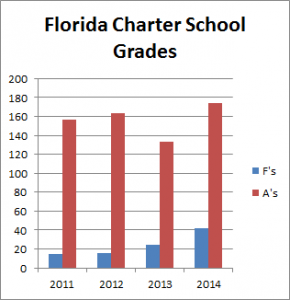The latest release of school grades was cause for celebration at some of Florida's charter school networks, which saw substantial improvements over last year.
At other schools, though, it brought bad news. Ramz Academy Middle School, a charter school in Miami-Dade, sent a letter to parents, informing them it would not be open next school year and offering to help them find another option. At the opposite end of the state, near the Georgia border, Shining Star Academy of the Arts in Columbia County was rallying parents, pursuing an appeal of its F grade, and preparing to seek a waiver allowing it to remain open next school year.

More Florida charter schools received grades this year, bringing an increase in the number of A's and the number of F's.
Florida statutes require most charter schools that receive F's in two straight years to close. In many cases, low test scores can either force them to shut down, as Hoggetowne Middle School in Alachua County announced before grades were released, or prompt efforts, like one now underway at Shining Star, to look for waivers or exceptions that can give them another year to improve.
In all, the double-F rule could affect an unprecedented eight elementary and middle schools around the state this year. Still more charter schools could face that reality next year, after 42 charters received F's, the highest single-year total ever. That number rose in part because there are more charter schools, and in part because a change in state law led to more charters being graded.
Most of this year's F-rated charters were receiving grades for the first time, either because they were new schools or too small to receive a grade the year before. Among the first-year charters that struggled was University Preparatory Academy, a high-profile effort to bring more education options to southern Pinellas County.
For many new charter schools - especially those that serve overwhelmingly low-income or minority students - it's common to receive poor grades in the early going, and then improve over time.
KIPP Impact Middle School in Jacksonville was struggling with an F four years ago. This year, it posted some of the highest scores in its history, and snared a B. Two other charter schools received F's as their first-ever grades in 2013, only to climb all the way to B's this year.
One of those, BridgePrep Academy Interamerican in Miami-Dade, caters to English Language Learners and is part of a small network of South Florida schools. The other, Renaissance Charter School at Chickasaw Trail, in Orlando, is operated by Charter Schools USA, one of the largest charter school management organizations in the state.
Richard Page, a senior vice president in charge of development at CSUSA, said the company keeps a "watch list" of schools that are struggling. New schools start on the list automatically, and have to earn their way off. While not every new school struggles out of the gate, test scores are often a "lagging indicator" of school improvement. He said when attendance rates climb and disciplinary incidents decline, those are signs the school's culture has taken hold and students will be more focused on learning.
This year, the company saw improvement throughout the state. Another second-year Charter Schools USA school in Central Florida, Renaissance Charter School at Poinciana, rose from a D to and A. All of the D and F schools the company managed last year rose to a C or higher this year.
Page said the company's growth has helped, as has the large number of schools that have been in operation for a few years and are starting to reach maturity. Its network of about 40 Florida schools supports a center with some 500 people who help schools improve their results and steer extra resources toward schools on the watch list. The support center also helps handle functions like purchasing and bookkeeping, allowing principals to focus on academics.
"We have absolutely seen our ability increased to provide more rigorous support where needed," he said. "That ability has grown as we have grown."
Some of Florida's highest-performing charter schools are so-called "mom-and-pops." And some well-known national networks have seen hiccups in their expansion plans. But this year's improvement at CUSA underscores the promise that some school choice proponents see in the growth of networks, not only for charter schools, but possibly for private schools as well.
There are other factors, though, that can affect academic results at new schools.
Two Miami-Dade charters that serve high proportions of low-income and minority students earned the dreaded double-Fs, but shared locations with schools that did not.
One of those was Ramz Academy Middle School, which is preparing to close. Its co-located elementary school, meanwhile, brought in Maybelline Truesdell, a longtime administrator for the local district. It received a C this year. Truesdell said the slightly older students at the middle school were more mobile, and more likely to leave during the school year, which made it harder to raise their scores.
In its letter to parents, the school's governing board pledged to help them find a new school for the coming year.
"Our Elementary school will continue operating and remains focused on providing the best educational environment and opportunities for success to our students," the letter said.